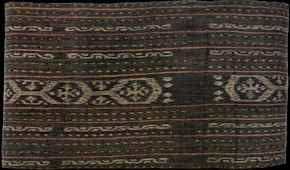| |
 mouse over to magnify mouse over to magnify
| | | | 198 Moluccas, Babar
Roie irai (sarong)
| | Locale: | Probably one of the smallest islands of the group. | | Period: | Early 20th c. | | Panels: | 4 | | Design: | Two main ikated bands show linked filled hexagons, a pattern known from early 20th C. Babar pieces. Narrower bands have small motifs such as those resembling stretched letters W and M that are common in the Tanimbar archipelago, 85Nm to the east. Remote Babar, not having a strong tradition around ikat (few links to class, caste, or place), was quite open to influence from cloths traded from other islands, e.g. for use as bridewealth, which can make precise identification difficult. Bottom border decorated with 160 sewed-on nassa shells. | | Size: | 60 x 185 cm (23.6 x 72.8 in) | | Weight: | 990 g (446 g/m2) | | Yarn: | Cotton, hand-spun, medium | | Comment: | Very long sarong of the type highly placed women wore on ceremonial occasions. It would be folded over to fit . Use of nassa shells as additional decoration suggests that the piece was highly valued by the maker, as this was done only to cloths of the highest rank. The imprecise weaving, which makes the hexagons look almost like circles, suggest that it was made on a remote place with little development. Most likely therefore it was not made on one of the larger islands, Babar, Wetan or Mesala, but on one of the tiny islands Dai, Dawera or Daweloor. Notable smell of skatol from decomposing indigo, indicating advanced age. Note that weight includes the shells. From Dutch colonial collection. | | Background: | Additional information in chapters on Moluccas and Babar. | | Published: | Ikat Textiles of the Indonesian Archipelago, 2018.
| | Compare: | 109 196 | | Sources: | Main motif of linked hexagons similar to that on ca. 1900 Kisar sarong in Khan Majlis, Indonesische Textilien, Wege zu Goettern und Ahnen, Fig. 500. (Kisar is 155 Nm to the west of Babar, about two days sailing in favourable winds.) Also similar to Babar sarongs on Fig. 557 and 560, except that their overall tonality is brown rather than indigo - brown and indigo being the two most common tones for the background of Babar sarongs. Comment on length p. 127, Main pattern similar to those on indigo and white sashes from around 1900 on Fig. 571 and 572. See close-up below of Babar sarong from Masela photographed in Rautenstrauch-Joest Museum's reserves. Note linked filled hexagons and reddish pinstripe.
 | | |
 ©Peter ten Hoopen, 2025
All rights reserved.
|
|


